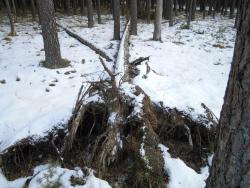Sale conditions
Sale conditions of wood are specified by the regulation of Director – General of the Sate Forests.
Within the framework of the individual sale , the foresters try to meet the fast growing demand, because more and more people use wood in order to heat their houses. Contrary to general opinion, these are not only village people, even though they prevail among recipients. The growth of firewood demand is the result of occurrence of new housing estates built in the suburbs of large agglomerations, where houses are usually equipped in fireplace heating installations.
Firewood is not only the most ecological heat source, but also is much more attractive in respect of relation of price and electric efficiency, rather than cola, oil, gas or electric power.
In recent years, the Sate Forests increased the sale of firewood of one third – up to over 4 million cubic meters annually. Firewood is not only the most ecological heat source, but also is much more attractive in respect of relation of price and electric efficiency, rather than cola, oil, gas or electric power. Some of customers choose already prepared and cut into pieces wood, the others very willingly obtain it by themselves after arranging all details and fulfilling particular safety conditions, and after paying the fee; that concerns mainly so called "thinnings". Such a raw material is very cheap, that is why many people from village areas profit from such possibility.
 Asset Publisher
Asset Publisher
 Asset Publisher
Asset Publisher
Dziwne stosy w lesie
Dziwne stosy w lesie
 Pułapka na cetyńce. Fot. W. Lemańczyk
Pułapka na cetyńce. Fot. W. Lemańczyk
 Stos pułapkowy. Fot. W. Lemańczyk
Stos pułapkowy. Fot. W. Lemańczyk
 Wywrot. Fot. W. Lemańczyk
Wywrot. Fot. W. Lemańczyk
 Wywrot. Fot. W. Lemańczyk
Wywrot. Fot. W. Lemańczyk
Przechadzając się wiosną po lesie, niejednego zaciekawią zagadkowe konstrukcje z drewna.
Pierwsze miesiące nowego roku to pora, w której leśnicy wykazują szczególną ostrożność na zagrożenie ze strony owadów uszkadzających drzewa. Należą do nich między innymi chrząszcze z rodziny kornikowatych: Cetyniec większy Tomicus piniperda oraz Cetyniec mniejszy Tomicus minor, które wraz ze wzrostem temperatury stają się aktywne.
Skuteczną obroną przed ich nadmierną działalnością jest wykładanie tzw. drzew pułapkowych. Ścięte drzewa, ułożone w stosy wydzielają w wiosennym słońcu intensywny zapach, który wabi owady. W pierwszej kolejności, na pułapki wykorzystuje się tzw. złomy i wywroty - drzewa powalone np. przez silny wiatr.
Miejscem wyłożenia drzew pułapkowych są nasłonecznione fragmenty lasu, w którym spodziewamy się występowania cetyńców. Stosy pułapkowe są co pewien czas sprawdzane pod kątem ich zasiedlenia i stopnia rozwoju owadów. Monitoring pułapek jest kluczowy, gdyż w momencie ich maksymalnego zasiedlenia, ale jeszcze przed wylotem młodych chrząszczy, należy wywieźć je z lasu lub okorować.
Gdy następnym razem zobaczysz podobne stosy drewna w lesie, przyjrzyj się im uważniej. W miejscach gdzie wysypują się jasnobrązowe trocinki znajdują się korytarze cetyńców.
Tekst: Piotr Chybowski






